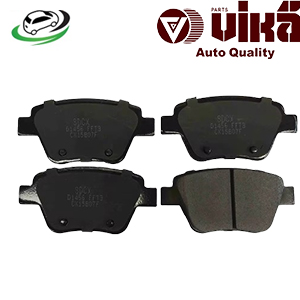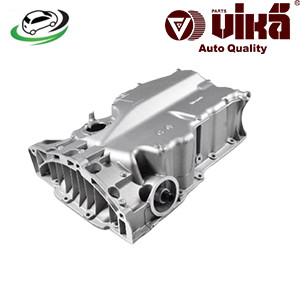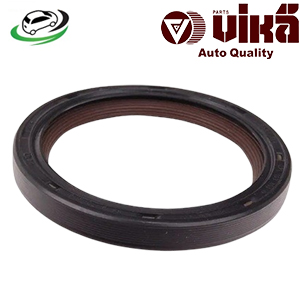-10%
Get Front Crankshaft Seal Audi B6 S4 V8/ Audi C5 Allroad/ Audi Q7 TDI/ RS7 4.0T/ VW Touareg 2/3-V6 TDI 079103051D
The crankshaft seal, often referred to as the main seal or crank seal, is a crucial component in an internal combustion engine. It plays a vital role in preventing oil leakage from the engine while ensuring the smooth operation of the crankshaft. Understanding the function, design, types, materials, signs of failure, and maintenance of crankshaft seals is important for anyone involved in automotive repair, maintenance, or engineering.
Function of the Crankshaft Seal
The crankshaft seal is designed to prevent engine oil from leaking out of the engine at the point where the crankshaft exits the engine block. This seal ensures that the oil remains within the engine’s lubrication system, where it can properly lubricate moving parts like the crankshaft, pistons, and bearings. Without a properly functioning crankshaft seal, oil could escape, leading to insufficient lubrication, potential engine damage, and environmental contamination.
There are two main crankshaft seals in most engines: the front crankshaft seal (located at the front of the engine, usually behind the timing cover) and the rear crankshaft seal (located at the rear of the engine, where the crankshaft connects to the transmission). Both seals serve the same purpose but are positioned differently due to the layout of the engine.
Design and Components of a Crankshaft Seal
The crankshaft seal is a relatively simple yet highly engineered component. It typically consists of the following parts:
- Outer Casing: The outer casing of the crankshaft seal is usually made of metal and is designed to fit snugly into the engine block or timing cover. It provides structural support for the seal and ensures a tight fit to prevent oil from leaking around the outside of the seal.
- Sealing Lip: The sealing lip is the most critical part of the crankshaft seal. It is usually made of a flexible material like rubber or synthetic elastomer. The lip creates a tight seal against the rotating surface of the crankshaft, preventing oil from escaping while allowing the crankshaft to rotate freely.
- Spring (Garter Spring): Many crankshaft seals include a small spring, known as a garter spring, which sits around the sealing lip. The spring helps maintain consistent pressure on the crankshaft, ensuring a tight seal even as the lip wears over time.
- Dust Lip: Some crankshaft seals also include a secondary lip, known as a dust lip, which is designed to keep dirt, debris, and contaminants out of the engine. This helps prolong the life of the seal and prevent damage to the crankshaft.
Types of Crankshaft Seals
Crankshaft seals come in various types, each designed for specific applications and operating conditions:
- Standard Rubber Seals: These are the most common type of crankshaft seals and are typically made from synthetic rubber materials like nitrile or silicone. They are suitable for most standard engines and provide a good balance of durability, flexibility, and cost-effectiveness.
- PTFE (Polytetrafluoroethylene) Seals: PTFE seals, also known as Teflon seals, are made from a high-performance plastic material that offers excellent resistance to heat, chemicals, and wear. PTFE seals are often used in high-performance or heavy-duty engines where higher temperatures and pressures are encountered.
- Double-Lip Seals: Double-lip seals have two sealing lips, providing an additional barrier against oil leakage and contaminants. They are often used in applications where extra protection is needed, such as in off-road vehicles or industrial machinery.
- Metal Reinforced Seals: These seals have a metal ring or reinforcement embedded in the rubber or elastomer. This design provides extra rigidity and strength, making them suitable for heavy-duty applications or engines that operate under extreme conditions.
- Split Seals: Split seals are designed to be installed without removing the crankshaft or disassembling the engine. They are typically used in applications where it is difficult or impractical to replace the seal with a standard, one-piece design. Split seals are commonly found in large industrial engines or older vehicles.
Materials Used in Crankshaft Seals
The material used in a crankshaft seal is crucial to its performance, durability, and resistance to various operating conditions. Common materials include:
- Nitrile Rubber (NBR): Nitrile is one of the most common materials used in crankshaft seals due to its good balance of oil resistance, temperature stability, and cost-effectiveness. NBR seals are suitable for most standard automotive applications.
- Silicone Rubber (VMQ): Silicone rubber offers excellent temperature resistance and flexibility, making it ideal for engines that operate at higher temperatures. However, silicone is less resistant to oil and fuel compared to nitrile.
- Polytetrafluoroethylene (PTFE): PTFE seals offer superior resistance to heat, chemicals, and wear, making them ideal for high-performance and heavy-duty applications. PTFE is also known for its low friction properties, which reduce wear on the crankshaft.
- Fluoroelastomer (FKM/Viton): Fluoroelastomer seals, commonly known by the brand name Viton, provide excellent resistance to high temperatures, chemicals, and oil. They are often used in high-performance or industrial applications where durability and reliability are critical.
Signs of Crankshaft Seal Failure
A failing crankshaft seal can lead to various issues, ranging from minor oil leaks to significant engine damage. It’s important to recognize the signs of a failing crankshaft seal so that it can be addressed promptly:
- Oil Leaks: The most obvious sign of a failing crankshaft seal is an oil leak at the front or rear of the engine. If you notice oil dripping from the front of the engine (around the timing cover) or from the rear (between the engine and transmission), it could indicate a damaged or worn crankshaft seal.
- Oil on the Undercarriage: Oil leaking from a crankshaft seal may spray onto the undercarriage of the vehicle, particularly when the vehicle is in motion. If you notice oil buildup on the underside of the engine or transmission, it could be due to a leaking seal.
- Low Oil Levels: A failing crankshaft seal can lead to gradual oil loss over time. If you find yourself frequently topping off the engine oil or notice a significant drop in oil levels between oil changes, it could be a sign of a leaking seal.
- Engine Misfires or Rough Idling: In rare cases, a severe crankshaft seal leak can allow oil to contaminate the engine’s ignition system, leading to misfires or rough idling. This is more likely to occur with a rear crankshaft seal leak, where oil can leak into the bell housing and affect the clutch or flywheel.
- Clutch Slippage (Manual Transmission): If the rear crankshaft seal is leaking, oil can seep onto the clutch disc, causing the clutch to slip. This can lead to poor acceleration, difficulty shifting gears, and increased engine RPMs without a corresponding increase in vehicle speed.
Causes of Crankshaft Seal Failure
Crankshaft seals can fail for a variety of reasons, including:
- Age and Wear: Over time, the materials in the crankshaft seal can degrade due to constant exposure to heat, oil, and mechanical stress. This can cause the seal to harden, crack, or lose its flexibility, leading to leaks.
- Improper Installation: If a crankshaft seal is not installed correctly, it may not form a proper seal against the crankshaft, leading to oil leaks. This can happen if the seal is misaligned, damaged during installation, or if the crankshaft surface is not clean and smooth.
- Crankshaft Wear or Damage: If the surface of the crankshaft where the seal contacts becomes worn, pitted, or damaged, the seal may not be able to maintain a tight seal. This can lead to oil leakage and may require the crankshaft to be repaired or replaced.
- High Crankcase Pressure: Excessive pressure in the engine’s crankcase can force oil past the crankshaft seal, leading to leaks. This can be caused by a malfunctioning Positive Crankcase Ventilation (PCV) system, which is responsible for regulating crankcase pressure.
Maintenance and Replacement of Crankshaft Seals
Maintaining and replacing crankshaft seals is essential for preventing oil leaks and ensuring the longevity of the engine:
- Regular Inspection: Periodically inspect the area around the crankshaft seals for signs of oil leakage. Early detection of a leak can prevent more serious engine damage.
- Proper Installation: When replacing a crankshaft seal, ensure it is installed correctly. The crankshaft surface should be clean, smooth, and free of any debris or old sealant. The seal should be seated evenly and securely in its housing.
- Crankcase Pressure Check: If a crankshaft seal failure is suspected, it’s a good idea to check the engine’s crankcase pressure. If the pressure is too high, it can cause repeated seal failures, and the underlying issue (such as a clogged PCV valve) should be addressed.
- Timely Replacement: If a crankshaft seal shows signs of wear, damage, or leakage, it should be replaced promptly. Delaying replacement can lead to more severe oil leaks, engine damage, and increased repair costs.
- Using High-Quality Seals: When replacing a crankshaft seal, use high-quality seals made from durable materials that are suitable for your engine’s operating conditions. Investing in quality seals can prevent premature failures and reduce the need for frequent replacements.
Follow us on Facebook for more parts.



